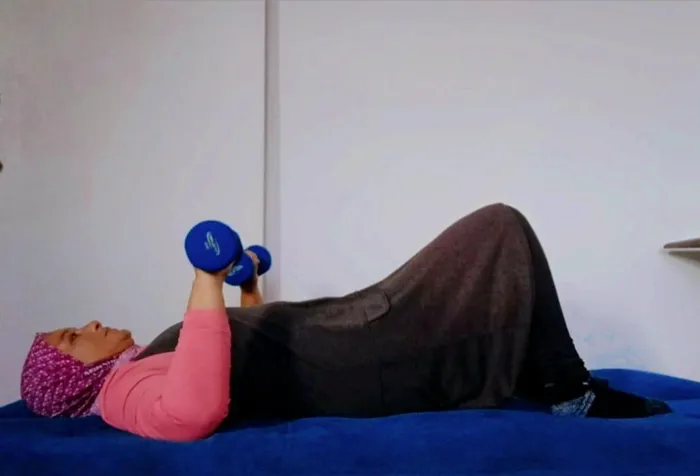Dumbbell chest press to release feelings of grief

Fitness1 Lie with your back on a bench or bed or mat and a dumbbell in each hand, resting at chest level.
Image: Picture: Supplied
ROSHAN ABRAHAMS, personal trainer, shares tips on how to release negative emotions through conscious exercise while saying positive affirmations.
These exercises can be done in Ramadaan as well as after. The Ramadaan focus is on holistically improving oneself mentally, physically, spiritually and emotionally.
The fourth and last week of Ramadaan, includes the 10 days of “Ashra of Salvation” where Muslims focus on seeking protection from the fires of hell and strive to be among those who are saved on the Day of Judgment.
To intensify their worship, Muslims make dua (pray) for the last 10 nights of Ramadaan, and engage in acts of kindness and charity, maximising the blessings and mercy of this holy period.
It’s necessary to prioritise one’s body and mind focusing on being kind to oneself and healing for those who have experienced grief and sadness.
Examples of trauma: if you are going through a divorce, recovering from an accident, been abused, or have experienced the death of a loved one.
Rhushana Kamaldien, emotional release coach, mindset coach, and wellness practitioner, shares her knowledge in the fourth part of this fitness series.
Rhushana says grief and sadness aren’t just emotions they affect your entire being, especially your heart.
"As a coach, I’ve seen how holding onto emotional pain can take a toll on the body.

Fitness2 Bend your knees and place your feet flat on the surface. Breathe out and begin to extend your arms and push the dumbbells up over your chest but do not lock your elbows.
Image: Picture: Supplied
Grief and sadness can lead to heart problems. When emotions aren’t processed, they build up inside, creating stress that impacts your heart health. One condition linked to emotional distress is broken heart syndrome (Takotsubo Cardiomyopathy). This happens when extreme stress or grief causes the heart’s main pumping chamber to temporarily weaken and change shape, mimicking a heart attack.
"People often experience chest pain, shortness of breath, and a racing heart but unlike a heart attack, there’s no blockage. Instead, a sudden flood of stress hormones like adrenaline overwhelms the heart. While most recover fully, it’s a clear sign of how deeply emotions affect the body.
"Beyond this, chronic stress increases cortisol levels, which can weaken the heart, disrupt the immune system, and leave the body in a constant state of tension. When emotions stay stuck, they show up in different ways: tightness in the chest, fatigue, restless sleep, or feeling drained no matter how much you rest.
"Emotions are energy, and when they’re not released, they store themselves in the body, leading to physical discomfort, stress, and even illness. That’s why I take a holistic approach to healing, combining bodywork, breathwork, and mindset techniques to help my clients release what’s weighing them down."

Fitness3 You can use equal size water bottles if you don't have dumbbells.
Image: Picture: Supplied
Healing modalities that help process and release emotional pain include breathwork and meditation journaling and mindset coaching, EFT tapping (emotional freedom technique).
Rhushana says grief isn’t something you just “get over” it’s something you move through. When left unprocessed, it can feel like a heavy weight on your chest, keeping you stuck in the past. However when you release it, you create space for peace, clarity, and a deeper connection to yourself.
If you’ve been carrying emotional pain, know that you don’t have to go through it alone. Healing is possible and it starts with releasing what no longer serves you.
As a personal trainer I would add that daily physical exercise with affirmations along with monthly massages, help to release toxins holistically.
The exercise that would release stored emotions of grief and sadness with affirmations is the dumbbell chest press and it can be done two or three times a week with rest days in between.
The chest press, whether using a machine or dumbbells, is a great exercise for building upper body strength, particularly in the chest, shoulders, and triceps, which can improve functional strength.
Strong chest muscles are crucial for everyday movements like pushing open a door, washing your hair, or lifting objects and in due time it will enhance performance in sports.
How to do a dumbbell chest press
Lie with your back on a bench or bed or mat and a dumbbell (or water bottle) in each hand, resting at chest level.
Bend your knees and place your feet flat on the surface.
Face your palms toward your feet with the dumbbells in each hand, elbows in line with your chest, not your shoulders and breath in.
Breathe out and begin to extend your arms and push the dumbbells up over your chest but do not lock your elbows.
You’ll feel tension across your upper chest.
Say these affirmations while pushing your arms up: “I release the pain and sadness.”
Repeat 10 times.
Remember the rhythm of the breathing helps to perform the full range of motion.
If you feel comfortable doing this exercise after a week or two you can increase the intensity to three sets per workout.